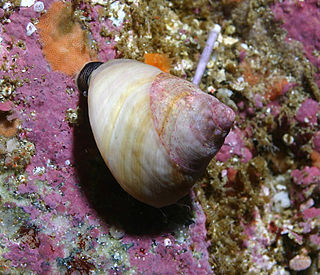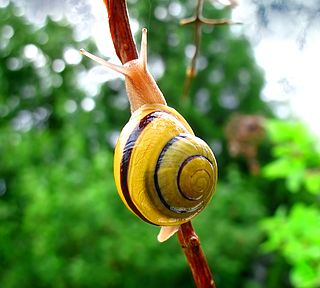
Pulmonata or pulmonates is an informal group of snails and slugs characterized by the ability to breathe air, by virtue of having a pallial lung instead of a gill, or gills. The group includes many land and freshwater families, and several marine families.

Littorinimorpha is a large order of snails, gastropods, consisting primarily of sea snails, but also including some freshwater snails and land snails.

Stylommatophora is an order of air-breathing land snails and slugs, terrestrial pulmonate gastropod molluscs. This taxon includes most land snails and slugs. Stylommatophorans lack an operculum, but some close their shell apertures with temporary "operculum" (epiphragm) made of calcified mucus. They have two pairs of retractile tentacles, the upper pair of which bears eyes on the tentacle tips. All stylommatophorans are hermaphrodites.

Neritoidea is a taxonomic superfamily of mostly sea snails, nerites and their allies, marine gastropod mollusks in the order Cycloneritida.

Buccinoidea is a taxonomic superfamily of very small to large predatory sea snails, marine gastropod mollusks.

Basommatophora was a term that was previously used as a taxonomic informal group, a group of snails within the informal group Pulmonata, the air-breathing slugs and snails. According to the taxonomy of the Gastropoda, whenever monophyly has not been tested, or where a traditional taxon of gastropods has now been discovered to be paraphyletic or polyphyletic, the term "group" or "informal group" was used.

Planorbidae, common name the ramshorn snails or ram's horn snails, is a family of air-breathing freshwater snails, aquatic pulmonate gastropod molluscs. Unlike most molluscs, the blood of ram's horn snails contains iron-based hemoglobin instead of copper-based hemocyanin. As a result, planorbids are able to breathe oxygen more efficiently than other molluscs. The presence of hemoglobin gives the body a reddish colour. This is especially apparent in albino animals.

Acroloxidae, commonly known as river limpets, are a taxonomic family of very small, freshwater snails, aquatic pulmonate gastropod limpet-like mollusks with a simple flattened conical shell in the clade Hygrophila.

Trochoidea is a superfamily of small to very large vetigastropod sea snails with gills and an operculum. Species within this superfamily have nacre as the inner shell layer. The families within this superfamily include the Trochidae, the top snails. This superfamily is the largest vetigastropodan superfamily, containing more than 2,000 species.

The Neotaenioglossa is a taxonomic name for a large group of mostly sea snails. The name was originally created by Haller in 1882. Ponder and Warén (1988), and Marquet (1997), assigned this name to the superorder Caenogastropoda. ITIS considers the order Neotaenioglossa to be a synonym of Cerithioidea Férussac, 1819 .
The taxonomy of the Gastropoda, as revised by Winston Ponder and David R. Lindberg in 1997, is an older taxonomy of the class Gastropoda, the class of molluscs consisting of all snails and slugs. The full name of the work in which this taxonomy was published is Towards a phylogeny of gastropod molluscs: an analysis using morphological characters.

Vetigastropoda is a major taxonomic group of sea snails, marine gastropod mollusks that form a very ancient lineage. Taxonomically the Vetigastropoda are sometimes treated as an order, although they are treated as an unranked clade in Bouchet and Rocroi, 2005.

Hygrophila is a taxonomic superorder of air-breathing freshwater snails, aquatic pulmonate gastropod mollusks within the clade Panpulmonata.

The subfamily Emarginulinae, common name keyhole limpets and slit limpets, is a taxonomic subfamily of limpet-like sea snails, marine gastropod molluscs in the family Fissurellidae, the keyhole limpets and slit limpets.

Panpulmonata is a taxonomic clade of snails and slugs in the clade Heterobranchia within the clade Euthyneura.
The taxonomy of the Gastropoda as it was revised in December 2017 by Philippe Bouchet and eight other authors, is a publication which lays out a newly revised system for the scientific classification of gastropod mollusks. The same work also included the taxonomy of monoplacophorans.

Euheterodonta is an subterclass of Mollusca in the class Bivalvia.
Trochida is an order of small to very large vetigastropods. It includes recent and extinct sea snails with gills and an operculum.














